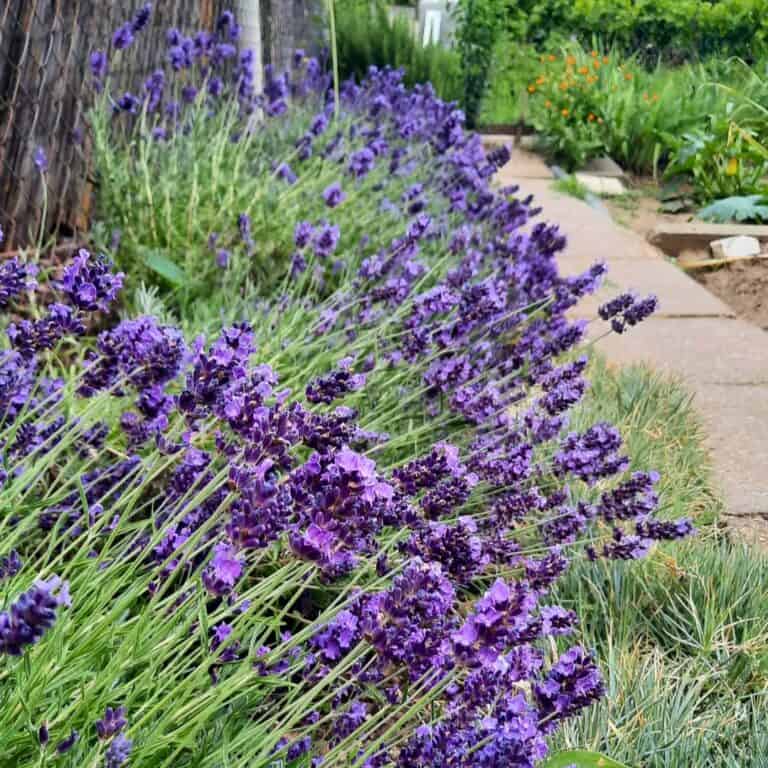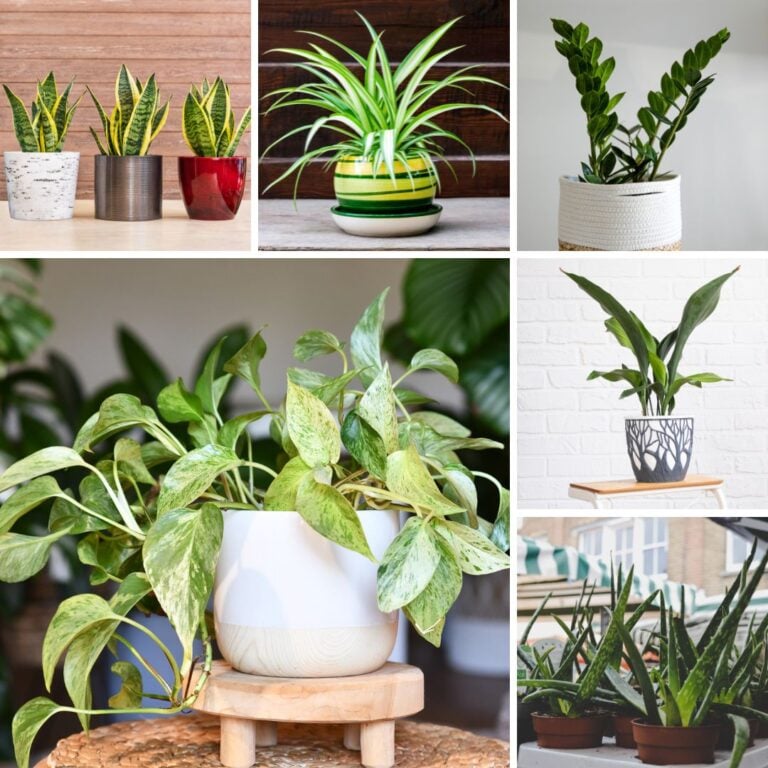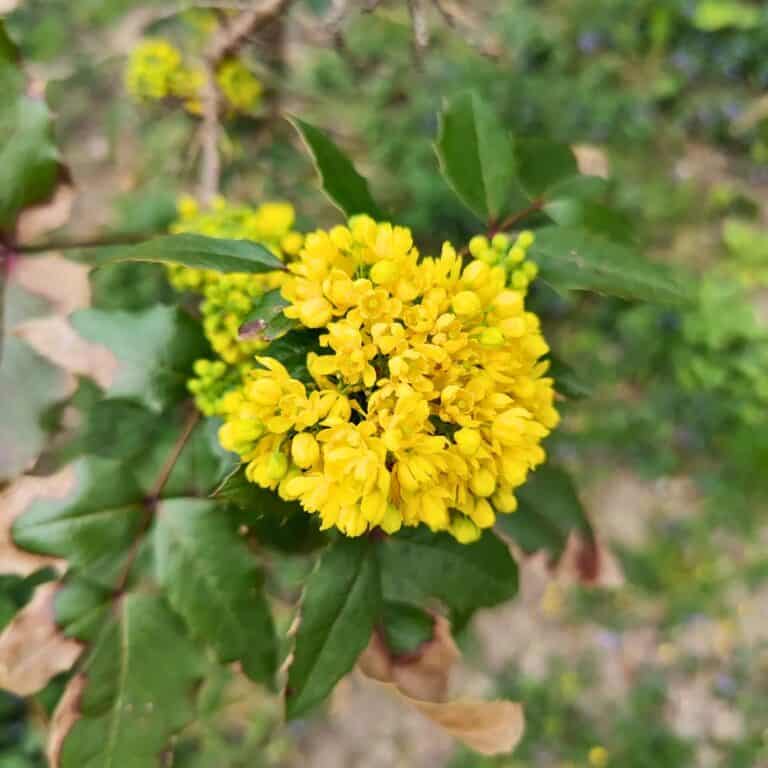8 Fast-Growing Vines to Try During Warm Months for Lush Garden Beauty
When the weather finally warms up, I love watching my garden explode with color and life.
Fast-growing vines are a super quick way to add greenery and a bit of magic to a yard, fence, or even a small balcony.
With the right vines, I get lush growth and pretty flowers all summer.
These plants are easygoing and can make any outdoor space feel more inviting—sometimes almost instantly.
Please note: Simplify Plants is reader-supported. As an Amazon Associate, I earn from qualifying purchases made by our readers with no extra cost added to you all! Some links in the post are affiliate links and I get a commission from purchases made through links in the post.
1) Sweet Potato Vine
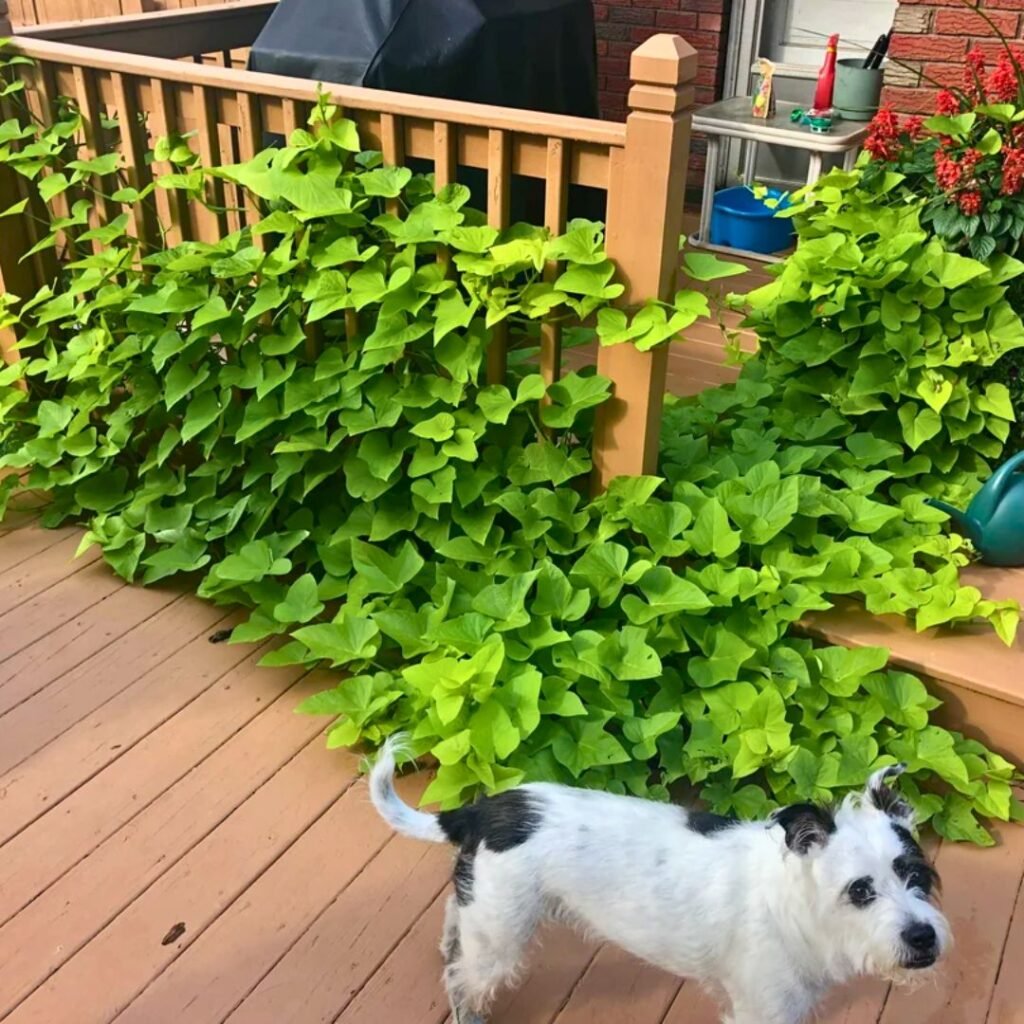
I’m a big fan of Sweet Potato Vine because it’s honestly one of the easiest and fastest vines I’ve tried. The leaves come in wild colors—bright green, deep purple, or nearly black—which gives instant flair to any garden or patio.
Sweet Potato Vine just takes off once the weather’s warm. I usually wait until after the last frost so the soil’s cozy for it. It works in containers or straight in the ground, which is handy.
This vine really doesn’t ask for much care. As long as it gets enough water, it’ll keep sprawling out and filling those empty spots. I do trim it now and then to keep things tidy.
Sometimes, small sweet potatoes pop up in the soil. They’re not exactly delicious, but I think they’re kind of fun to find.
I love mixing Sweet Potato Vine with flowers like petunias or marigolds. The vines spill over pots and make every container look fuller and a bit more alive.
It likes full sun, but honestly, it’ll deal with some shade too. The colors might fade a bit in shadier spots, but it still grows.
If I want it to stay small, I just give it less room. When I want a big, bold look, I let it trail and climb wherever it wants.
Watching how fast those leaves spread in summer is just the best. Sweet Potato Vine is such a simple, pretty option if you want fast results in a warm-season garden.
2) Morning Glory

I always end up planting Morning Glory because it fills up a fence or trellis in no time. The bright, funnel-shaped flowers pop open early, making my mornings a little more colorful.
Morning Glory is easy to start from seeds. I’ll soak them overnight to help them sprout faster, and then just stick them in the dirt. This vine loves full sun and can handle the heat.
The vines can shoot up over six feet in a few weeks. I set them up with a fence or an arch to climb, and they twist around on their own, which is pretty convenient.
There are so many colors—blue, purple, pink, white. Mixing different types looks amazing. Each flower only lasts a day, but the plant keeps cranking out new blooms all summer.
Morning Glory doesn’t need much. I water when the soil feels dry and avoid overwatering since soggy roots are a no-go. A little balanced fertilizer helps if the leaves look pale.
I keep an eye out because the seeds are toxic if eaten, so I’m careful with pets and kids. Deadheading old blooms keeps the vines neat and encourages more flowers.
Growing Morning Glory just makes the garden feel more alive. The fast growth and bright flowers are honestly a joy.
3) Black-eyed Susan Vine
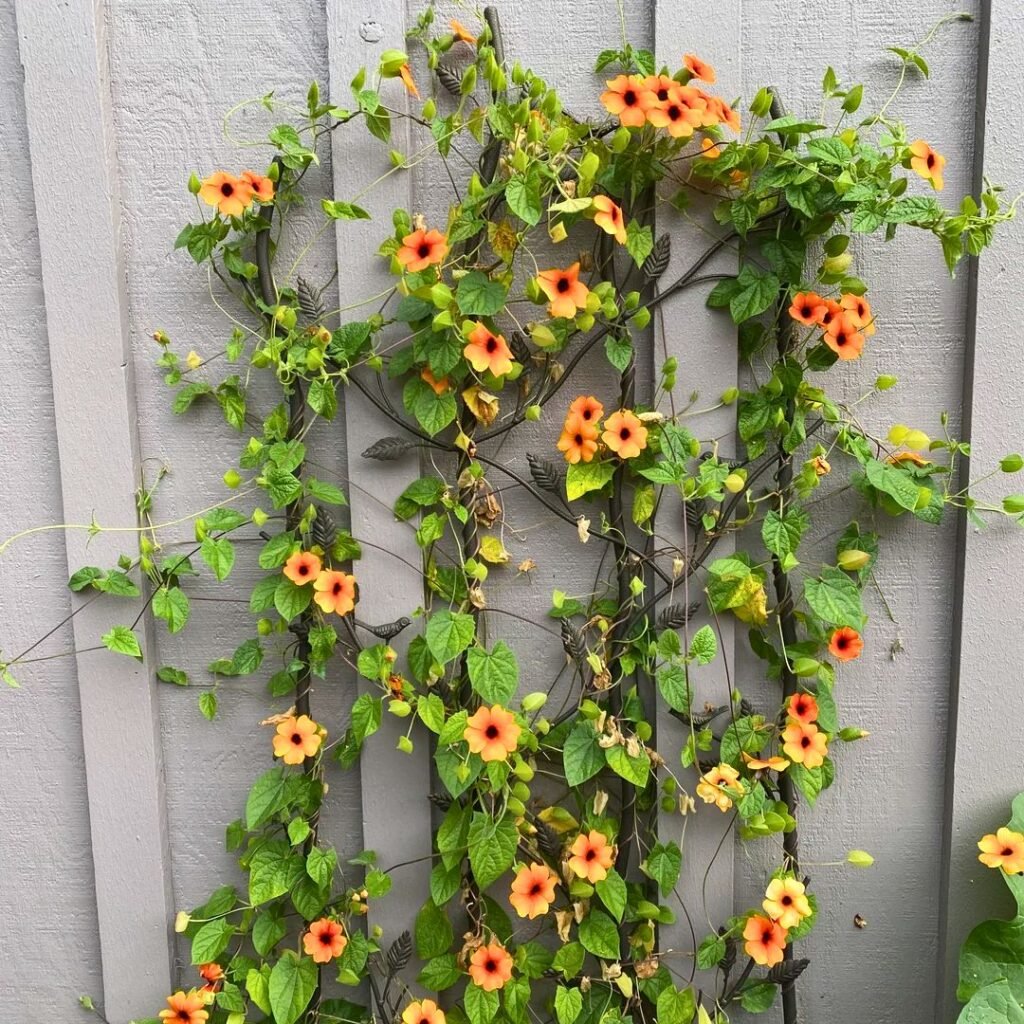
Black-eyed Susan Vine is a favorite for a burst of color. The flowers are bright yellow or orange with a dark center, and they really pop against the green leaves.
This vine grows super fast in summer. I’ve seen it cover fences and trellises in no time, making the space look way more cheerful.
It does best in full sun but will still grow with a bit of shade. I just water it regularly and make sure the soil drains well—soggy roots are never good.
I usually start mine from seeds indoors, but picking up young plants works too. Once they’re settled, they barely need any help except for regular watering when it’s hot.
The blooms attract butterflies and sometimes hummingbirds, which adds a nice vibe to the garden.
It’s not invasive and safe for most gardens, but I always double-check if it plays nicely with my other plants.
I like it in pots, hanging baskets, or climbing up arbors and fences.
Black-eyed Susan Vine is easily one of my top picks for fast, cheerful color during the warm months.
4) Hyacinth Bean
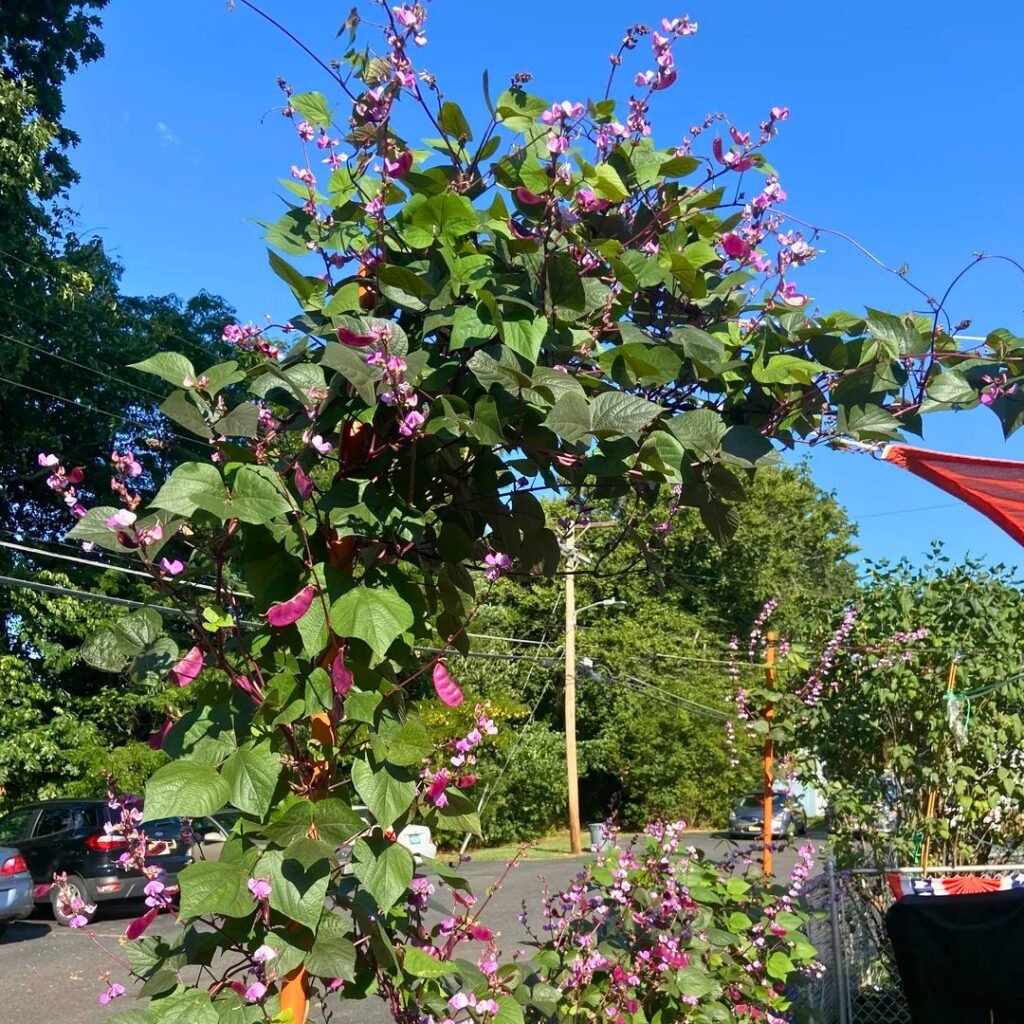
Hyacinth Bean is one of those vines that just takes off in the heat. It’s easy to grow, which is perfect if you want fast results.
The stems are a cool purple, and the leaves are deep green. When it blooms, the purple flowers and seed pods really stand out.
I plant the seeds after the last frost. Hyacinth bean loves full sun and needs well-drained soil. I always give it a sturdy trellis or fence to climb.
The vines can stretch 10-15 feet in a single summer. They’re great for covering up blank walls or arbors. I water whenever the soil feels dry.
Hyacinth Beans attract bees and butterflies, so my garden feels lively. Even in hot weather, they keep on blooming.
These are grown for looks, not for eating. Some parts aren’t safe to eat unless you know what you’re doing, so I just enjoy the color.
Hyacinth bean really livens up the garden quickly. If you want a fast-growing vine with bold color, this one’s a solid choice.
5) Scarlet Runner Bean
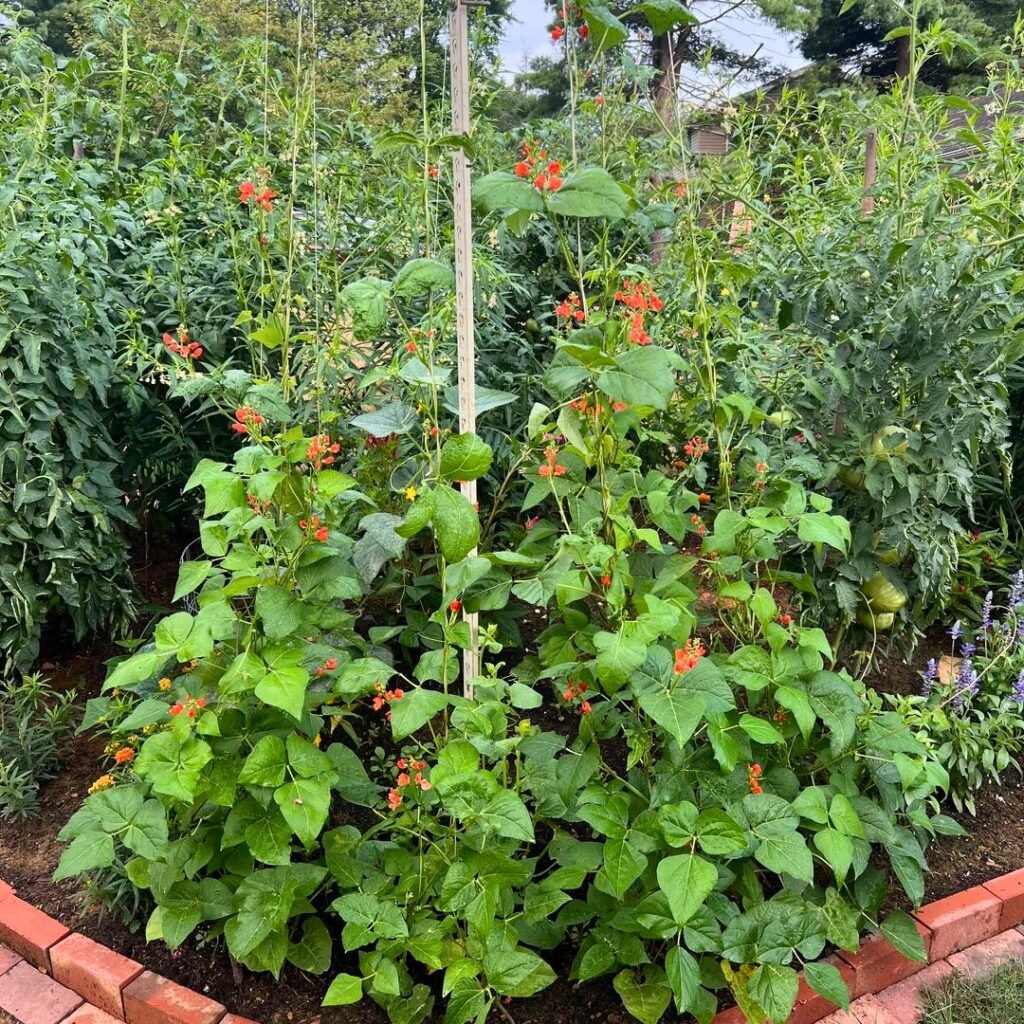
Scarlet Runner Bean is another vine I can’t resist in summer. It grows fast and the bold red flowers are a magnet for hummingbirds—I see them almost every day.
It climbs up fences, trellises, or even poles with hardly any help. I just plant the seeds after the last frost, and the vines shoot up fast. They can easily hit 10 feet or more in a few weeks.
I water to keep the soil moist but not soggy. These vines love full sun and need plenty of space so they don’t get tangled.
The beans are edible when young and tender. I pick them small for the best flavor, but if I let them mature, the seeds are pretty too—purple and black.
It’s also great for privacy. Along a fence or wall, it creates a lush green screen with bright flowers.
Scarlet Runner Bean is practical and pretty. It’s a favorite of mine when I want quick cover and a splash of color.
6) Trumpet Vine
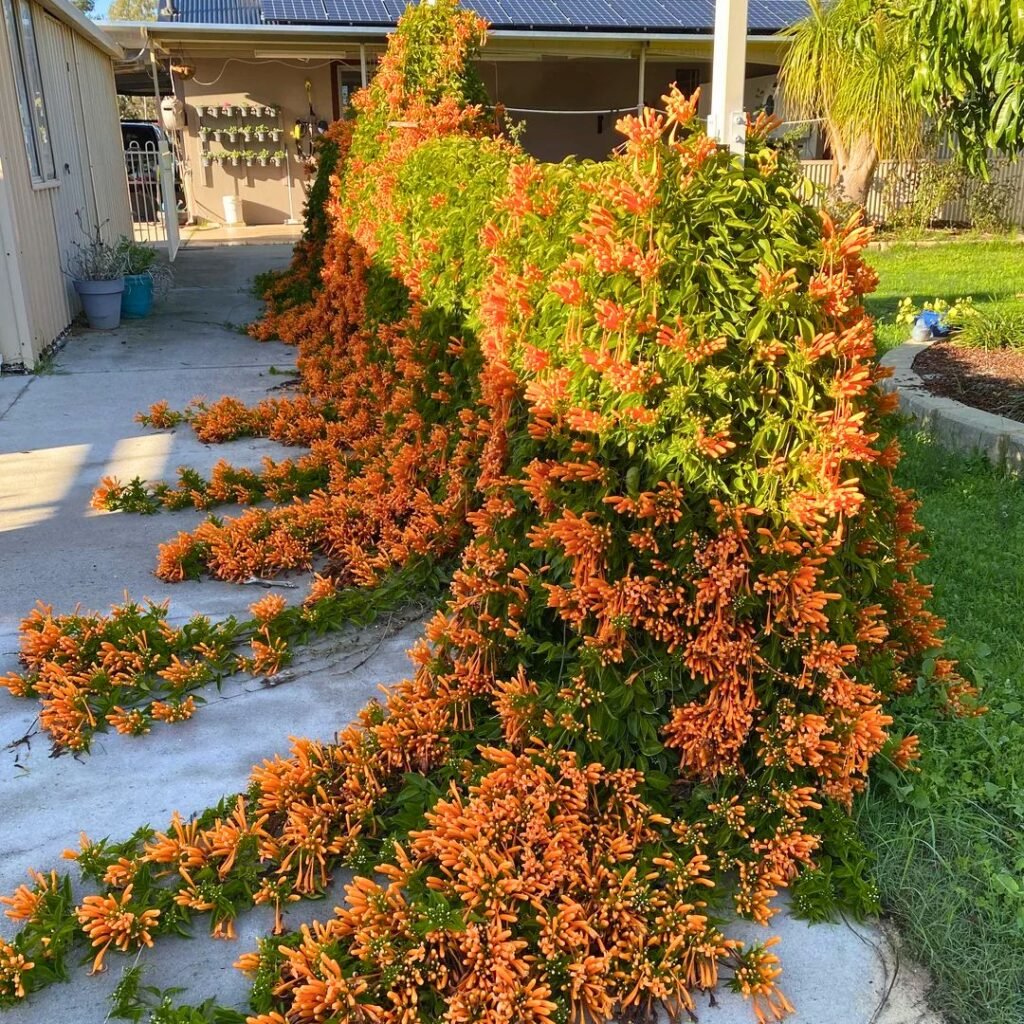
Trumpet vine is one of the easiest and fastest vines I’ve tried in warm weather. The bright orange-red flowers are impossible to miss and hummingbirds love them.
It can grow several feet in a season, no problem. Full sun is best, and it’ll even deal with poor soil. Trumpet vine is tough and doesn’t fuss much.
The stems attach themselves to walls, fences, or trellises, so I don’t have to tie them up. If I want more growth, I water it often and let it do its thing.
I’m careful to prune it regularly since it can take over if I’m not paying attention.
This vine blooms all summer and sometimes into fall. The trumpet-shaped flowers are where it gets its name.
It’s great for adding shade over arbors or pergolas. Even though it can get big, regular trimming keeps it in line.
I’ve noticed more bees and butterflies show up when trumpet vine flowers. It just makes the yard feel more alive.
7) Clematis
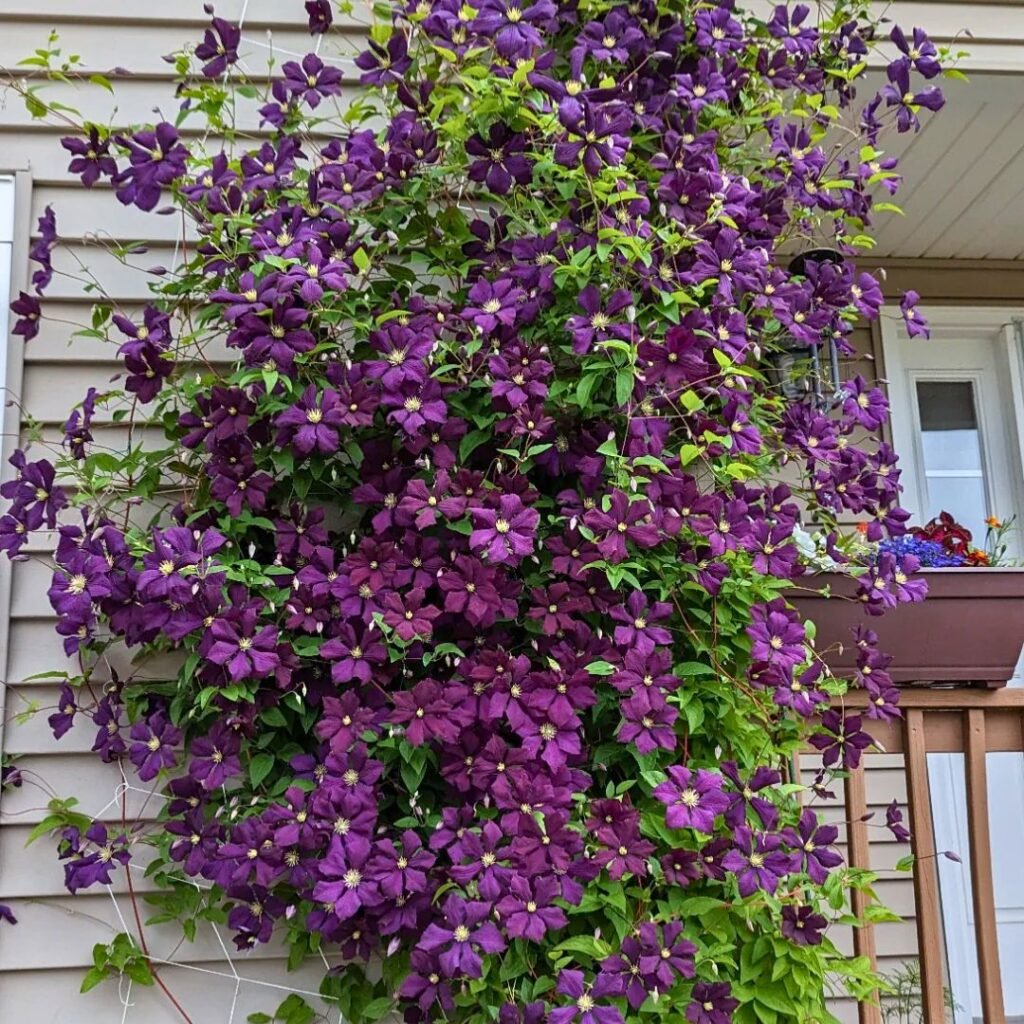
When I want a vine that brings instant charm, I almost always pick Clematis. The flowers come in purple, pink, white, or blue, and they look amazing against dark green leaves.
Clematis is happy in full sun or light shade, so it fits in a lot of gardens. I keep the roots cool and shaded since they don’t like baking in the heat. Mulch or low plants help with that.
It climbs easily if I give it a trellis or fence. The vines wrap around supports with their leaf stems and can grow several feet in just one warm season.
Clematis likes regular watering, especially when it’s dry. I try not to let the soil dry out, but soggy soil is bad news. Well-drained soil is key.
The flower shapes and sizes are all over the place—some are big and star-shaped, others are small and bell-like. Most types bloom in late spring or early summer, but a few keep going later.
For more blooms next year, I prune Clematis after flowering, depending on the type. Some need just a little trim, others a bigger cut. Proper pruning really helps.
Clematis adds color and height to fences, mailboxes, or arbors. It’s such a simple way to make the garden look more lively during the warm months.
8) Passionflower
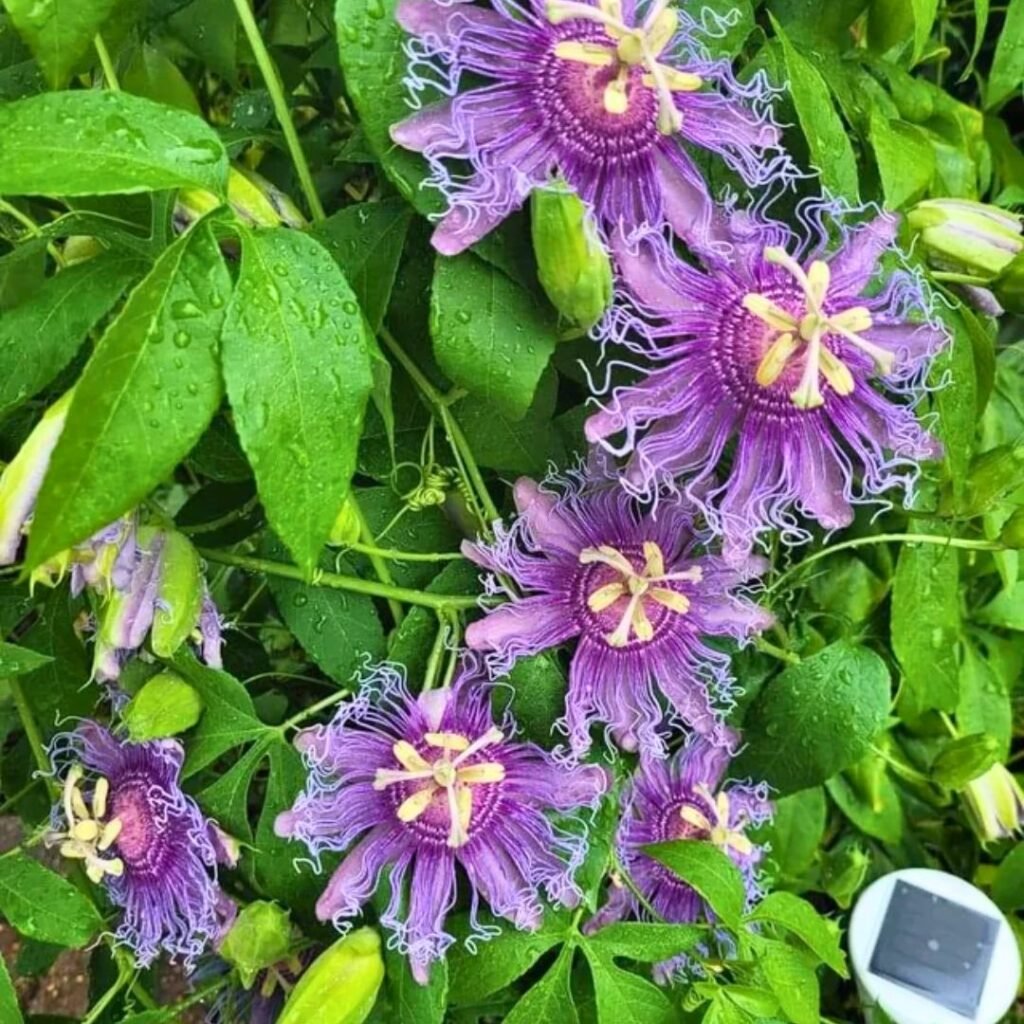
Passionflower is a vine I grow for both speed and looks. It can cover a fence or trellis super fast when things heat up.
The flowers are wild—purple, blue, or white, and the shape is just eye-catching. Bees and butterflies seem to love them, keeping the garden buzzing.
Passionflower vines can reach 20 feet in a single season if they get enough sun and water. I pick a spot with full sun or partial shade.
It likes well-drained soil, and I water it regularly during dry spells.
I’ve seen caterpillars munch on the leaves, but they rarely do much damage. Sometimes, passionflower even makes little fruits by late summer.
Training it up a trellis or fence is easy—the tendrils grab on by themselves.
Because it grows so fast, I trim it back now and then so it doesn’t crowd out other plants. Passionflower is just a fun, bold choice for anyone who wants a showy climber in warm weather.
Care Tips for Thriving Vines
Healthy vines need the right soil, enough sunlight, and regular watering and food. I’ve found that paying attention to these basics makes all the difference for strong, happy plants.
Ideal Soil and Sunlight Requirements
I always start with well-draining soil—it just makes everything easier. Most fast-growing vines hate heavy, soggy ground, so I toss in compost or organic matter to keep things loose and rich. That way, roots can actually breathe.
Sunlight matters a lot. Most flowering vines, like morning glories and clematis, really want full sun—at least 6 hours of direct sunlight each day. Some shade-tolerant vines, like English ivy, are happier with less light. I usually check the plant tag or seed packet before picking a spot, just to be sure.
Here’s a quick table I use:
| Vine Type | Sun Needs | Soil Type |
|---|---|---|
| Morning Glory | Full sun | Loamy, well-drained |
| Clematis | Full sun to part shade | Rich, moist, well-drained |
| English Ivy | Partial to full shade | Average, moist |
Watering and Fertilizing Recommendations
Keeping vines evenly moist is pretty important, especially when they’re putting on a growth spurt in the warmer months. I usually water deeply once or twice a week, not just a splash every day—deep watering helps the roots dig in.
If it hasn’t rained, I poke my finger about 2 inches into the soil. If it’s dry, I grab the hose. But soggy soil? Nope, that’s a recipe for root rot, so I avoid overdoing it.
Fertilizing makes a big difference. I go for a balanced, slow-release fertilizer in early spring when new growth is just getting started. For vines that flower, too much nitrogen just means more leaves and not enough blooms, so I actually read the directions. Fertilizing late in summer isn’t my thing—it can push out tender growth that might get zapped by early frosts.
For easy reference:
- Water when soil is dry 2” down
- Fertilize in early spring
- Don’t over-fertilize—follow the instructions
Training and Supporting Your Vines
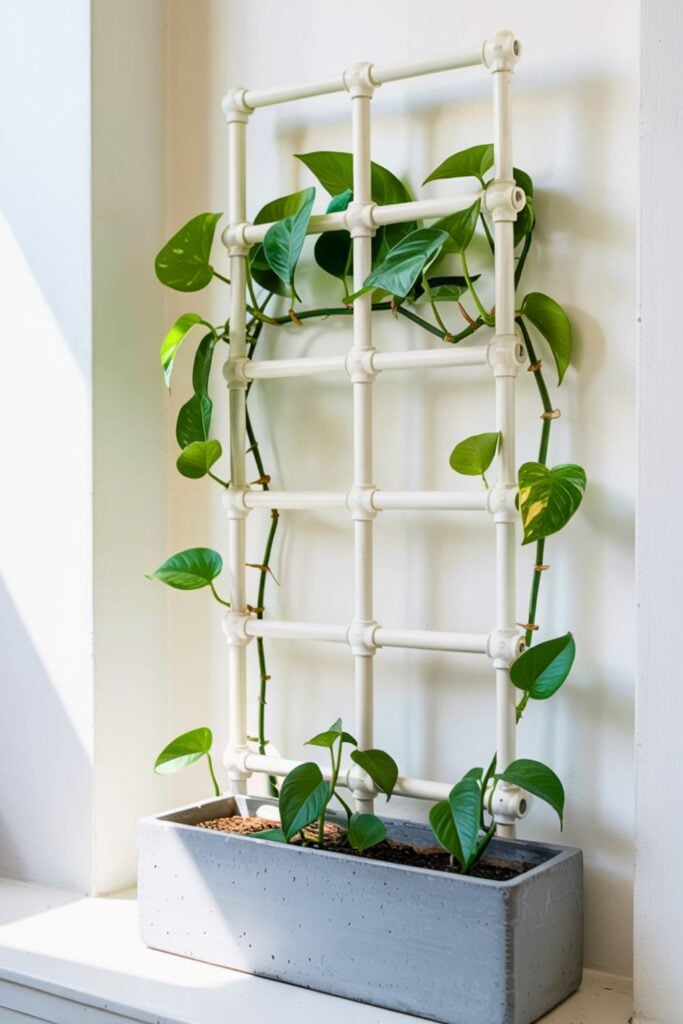
I’ve noticed that fast-growing vines need the right support and a bit of guidance as they climb. Picking strong structures keeps them from getting tangled or flopping over.
Best Structures for Fast-Growing Vines
I like to use trellises, fences, arbors, and garden stakes. These keep vines off the ground and looking tidy. A sturdy trellis works great for morning glories and sweet peas.
Chain-link fences? Perfect for climbing roses and trumpet vines—they just grab onto the wire. For wisteria or grapevines, a solid arbor gives them something dramatic to arch over.
If I’m short on space, I’ll go for bamboo stakes or mesh netting—super simple for beans and peas. I always double-check that whatever I use can handle the plant’s weight, especially after a rain.
Tip: I guide young stems using soft plant ties or twine so I don’t snap anything. Setting up support before planting saves me a headache later.
Frequently Asked Questions
People often ask how to quickly add greenery, blooms, or privacy to a space. Some vines really stand out for their speed, toughness, and ability to handle different spots.
What are some evergreen climbers that can provide quick privacy screening?
For evergreen coverage, I like Star Jasmine and English Ivy. They hold onto their leaves all year and grow fast once it gets warm.
Which vines would be suitable for rapid growth in full sun conditions?
Morning Glory and Hyacinth Bean love full sun. The more light and warmth, the faster they go. Both can cover a fence or trellis in one season—kind of impressive, honestly.
Can you recommend any fast-growing climbing plants that also flower?
I’m a fan of Black-eyed Susan Vine and Scarlet Runner Bean for quick color. They shoot up fast and keep blooming all summer. Their flowers are bright, and they make any fence or trellis look lively.
How do I choose the best fast-growing climbers for potting?
I’d go for compact vines like Sweet Potato Vine or Black-eyed Susan Vine. They’re happy in pots and easy to move around. Just make sure the pot drains well and gets enough sun.
What are some of the most hardy climbers that grow quickly?
If you need something tough, English Ivy is a solid choice for rougher climates. For annuals, Morning Glory and Hyacinth Bean sprout fast and don’t need much fussing.
Which fast-growing vines are best for covering fences for increased privacy?
Honestly, I’m a big fan of the Scarlet Runner Bean and Sweet Potato Vine. They really take off quickly and can cover a fence in no time.
Their lush, dense leaves do a great job of blocking out unwanted views. If you’re after a green, living privacy screen, these two are solid choices.
Note: Some images in the articles are sourced from Reddit and Other Platforms For Reference Purpose.

